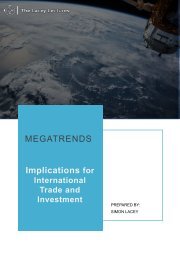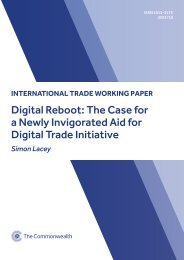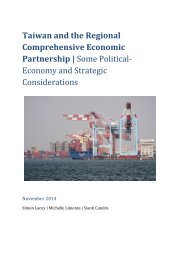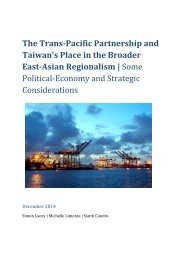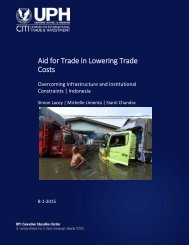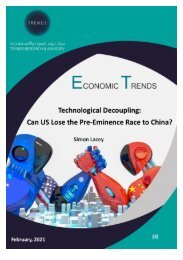Cross Border Data Flows: The impact of data localisation on IoT
This industry report seeks to shed new light on the costs of imposing data localization requirements or other restrictions on cross-border data flows with respect to the important economic growth likely to result from the uptake and adoption of IoT in manufacturing, agriculture and other important sectors of the economy. It chooses 3 large emerging markets in order to showcase its model, namely Brazil, Indonesia and South Africa.
This industry report seeks to shed new light on the costs of imposing data localization requirements or other restrictions on cross-border data flows with respect to the important economic growth likely to result from the uptake and adoption of IoT in manufacturing, agriculture and other important sectors of the economy. It chooses 3 large emerging markets in order to showcase its model, namely Brazil, Indonesia and South Africa.
You also want an ePaper? Increase the reach of your titles
YUMPU automatically turns print PDFs into web optimized ePapers that Google loves.
CROSS-BORDER DATA FLOWS: THE IMPACT OF DATA LOCALISATION ON IOT<br />
Results <str<strong>on</strong>g>of</str<strong>on</strong>g> Scenario 1: c<strong>on</strong>siderable GDP gains from <strong>IoT</strong>.<br />
Overall, we see major increases to GDP from <strong>IoT</strong><br />
deployment — between 0.5% to 2.2% <str<strong>on</strong>g>of</str<strong>on</strong>g> GDP compared<br />
to a baseline where the use <str<strong>on</strong>g>of</str<strong>on</strong>g> <strong>IoT</strong> in the ec<strong>on</strong>omy is<br />
c<strong>on</strong>stant — compared to today. To put these numbers<br />
in c<strong>on</strong>text, the gains predicted from <strong>IoT</strong> deployment<br />
are similar to those <strong>on</strong>e would expect to see from<br />
implementing major policy or tax reforms, or from a<br />
free trade agreement with a major trading partner.<br />
<str<strong>on</strong>g>The</str<strong>on</strong>g>se very large numbers are explained either by the<br />
productivity shocks in the GSMA Intelligence study<br />
or the AVE cuts in the WTO study. N<strong>on</strong>etheless, the<br />
dynamic effects provided by the CGE modelling <strong>on</strong> the<br />
nati<strong>on</strong>al output (GDP) doubles the original productivity<br />
gains. As expected, the dynamic effects from welfare<br />
increases, str<strong>on</strong>ger demand, better competitiveness<br />
and greater variety <str<strong>on</strong>g>of</str<strong>on</strong>g> products augment the original<br />
productivity boost created by the use <str<strong>on</strong>g>of</str<strong>on</strong>g> <strong>IoT</strong>.<br />
<str<strong>on</strong>g>The</str<strong>on</strong>g>se effects can be explained in different ways.<br />
<str<strong>on</strong>g>The</str<strong>on</strong>g> overall GDP gains are the result <str<strong>on</strong>g>of</str<strong>on</strong>g> broad-based<br />
productivity increases and the dynamic effects that<br />
<str<strong>on</strong>g>impact</str<strong>on</strong>g> the ec<strong>on</strong>omy as a whole since <strong>IoT</strong> technologies<br />
themselves generate both first and sec<strong>on</strong>d-order<br />
ec<strong>on</strong>omic effects. An example <str<strong>on</strong>g>of</str<strong>on</strong>g> first-order effects<br />
would be the direct <str<strong>on</strong>g>impact</str<strong>on</strong>g> <str<strong>on</strong>g>of</str<strong>on</strong>g> procuring and installing<br />
thousands <str<strong>on</strong>g>of</str<strong>on</strong>g> new <strong>IoT</strong> sensors, or c<strong>on</strong>tracting for<br />
additi<strong>on</strong>al <str<strong>on</strong>g>data</str<strong>on</strong>g> storage capacity as a result <str<strong>on</strong>g>of</str<strong>on</strong>g> the <str<strong>on</strong>g>data</str<strong>on</strong>g><br />
these sensors will produce. An example <str<strong>on</strong>g>of</str<strong>on</strong>g> sec<strong>on</strong>dorder<br />
effects would be the ec<strong>on</strong>omic activity generated<br />
from new soluti<strong>on</strong>s and services that companies<br />
operating in the <strong>IoT</strong> space are able to devise and sell <strong>on</strong><br />
the basis <str<strong>on</strong>g>of</str<strong>on</strong>g> the <str<strong>on</strong>g>data</str<strong>on</strong>g> now being captured by the newly<br />
procured and installed sensors. This is a very basic<br />
example, but it should give the reader an idea <str<strong>on</strong>g>of</str<strong>on</strong>g> how<br />
the productivity gains and dynamic effects interact<br />
with <strong>on</strong>e another to generate gains across the ec<strong>on</strong>omy<br />
as a whole.<br />
Both first and sec<strong>on</strong>d order effects can result in an<br />
uptick in exports, imports, investment and employment,<br />
depending <strong>on</strong> how <strong>IoT</strong>-related goods and services are<br />
produced and c<strong>on</strong>sumed.<br />
Table 5<br />
Comparis<strong>on</strong> <str<strong>on</strong>g>of</str<strong>on</strong>g> GDP effects (%).<br />
Comparis<strong>on</strong> to the TFP shock introduced.<br />
GDP<br />
Original TFP shocks<br />
Brazil 0.5 0.27<br />
Ind<strong>on</strong>esia 0.9 0.24<br />
South Africa 2.6 0.17<br />
In the case <str<strong>on</strong>g>of</str<strong>on</strong>g> Brazil, introducing <strong>IoT</strong> and related<br />
technologies resulted in: annual average GDP gains <str<strong>on</strong>g>of</str<strong>on</strong>g><br />
0.5% (which is primarily derived from the improved<br />
trade balance); and an extraordinarily high boost<br />
to exports (at 2.4%), with <strong>on</strong>ly a modest increase in<br />
imports (presumably because the Brazilian ec<strong>on</strong>omy<br />
already exudes str<strong>on</strong>g export orientati<strong>on</strong>). Other GDP<br />
comp<strong>on</strong>ents see a relatively small change compared to<br />
exports. It is recognised that str<strong>on</strong>g export orientati<strong>on</strong><br />
typically results in reduced investment, and this<br />
is borne out in this case with investment in Brazil<br />
dropping by 0.5%.<br />
17




